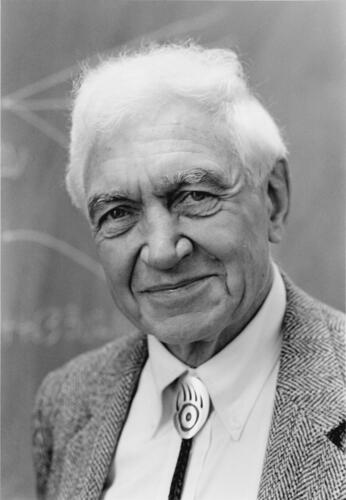
Professor Vernon W. Hughes, Sterling Professor Emeritus at Yale University, and elementary particle physicist, died on March 25, 2003.
Professor Hughes’ career involved a broad spectrum of studies of physical phenomena ranging in energy from the very low to the very high. But it consistently maintained the theme of understanding the physics of elementary particles and their interactions at the most fundamental level.
Born in Kankakee, IL on May 28, 1921, he attended Columbia University, where he received an AM degree in 1941 and a Ph. D. in 1950. His sponsor was the Nobel Prize winning physicist, I.I. Rabi. In his thesis work, conducted with L. Grabner, he observed for the first time a phenomenon involving the interaction of light with molecules. Hughes’ work was a pioneering investigation of effects which are important factors in modern laser studies of the properties of light and matter.
During the Second World War he helped develop radar at the MIT Radiation Laboratory and was one of the coeditors a volume of the Radiation Laboratory Series entitled Waveforms –a volume that has been of major significance to the development of the American electronics industry.
He conducted extensive studies of the simple positronium atom (a hydrogen-like atom consisting of a positive and negative electron pair) and helium (an atom with two electrons).
One area for which Professor Hughes is particularly well known is the study of atomic and particle physics by means of experiments with muonium - the atom formed by an electron bound to an elementary particle called the muon. This began with his making the first observation of this fundamental atom in 1960. It evolved with precision measurements of the influences of magnetic fields on the atom, led to an improved measurement of the magnetic properties on the muon, and matured to extremely precise measurements.
These thirty five years of experimentation, verifying to high precision that the muon is indeed a “heavy electron”, provided new avenues into the experimental study of quantum electrodynamics, and created a tool to probe the highest energy scales of elementary particle physics
Professor Hughes was the originator of another field of great importance: the use of polarized electrons in high energy accelerators. In the more common unpolarized beams, the individual electrons spin around themselves (like the earth does every 24 hours) around axes of rotation that are randomly oriented. In a polarized beam they preferentially point in one direction. The existence of this preferred direction then allows for a whole new array of possible measurements. His interest in polarized electron beams began in 1959, and he developed the first polarized source for the Stanford two mile accelerator. His vision and perseverance led to the first measurements of the internal structure of the proton that revealed not only the particles within, but also their spin, and to the historic observation of parity non-conservation (that is, the fact that nature distinguishes between an experiment and its mirror image) in deep inelastic electron scattering in which photons (particle of light) bounced off protons and neutrons. More recently, the successes of the Stanford Linear collider experiments in probing the electroweak interaction with polarized electrons colliding with positrons are directly traceable to Professor Hughes’ seminal work.
Professor Hughes’ pioneering work also opened the field of nuclear physics to investigations with polarized electrons at low energy accelerators. The first such experiment in this country was performed by him and his collaborators at the Bates linear accelerator where they observed parity violation in polarized electron-Carbon elastic scattering.
Extending the reach of deep inelastic polarized lepton scattering from nucleons, Professor Hughes led a large collaboration at the European accelerator in Geneva, Switzerland in investigations in employing polarized muons scattering from polarized neutrons and protons. This work was stimulated by the “proton spin crisis” first observed by Professor Hughes and his group, and led to more complete understanding of the relationship between the nature of the constituents of the proton and its spin.
Most recently Professor Hughes conceived of and led an experiment at Brookhaven National Laboratory to greatly improve the measurement of magnetic properties of the muon. This quantity embodies our knowledge of the interactions of elementary particles in one parameter. It has long served as crucial parameter with which we can test new ideas in particle physics.
He was on the Yale University faculty from 1954 until his retirement in 1991. He was Sterling Professor, the highest honor that Yale can bestow. He was chairman of the Physics Department there from 1961 to 1966 and presided over a large expansion of the Department. He received many honors, which included membership in the National Academy of Sciences, an honorary doctorate from the University of Heidelberg, and both the Davisson-Germer Prize in Atomic Physics and the Tom R. Bonner Prize in Nuclear Physics of the American Physical Society.
Professor Hughes’ focus was always on the most fundamental questions in physics and his development of ultra precise experimental techniques allowed him to establish several of the fundamental constants characterizing our universe and all its wonderful phenomena, with unprecedented precision.
Never satisfied until he fully understood whatever phenomenon he studied, Professor Hughes educated a generation of students who have become leaders in the international scientific community. He will be much missed worldwide by all his friends and collaborators, most especially by his colleagues at Yale who admired his endless supply of energy and drive and unyielding persistence.
Vernon Hughes was predeceased by his former wife Inge and is survived by his wife, Miriam of New York City, and his two sons, Gareth of Albuquerque and Emlyn of Pasadena, and four grandchildren, Ariel, Isaac, Noah and Inge Jovana.